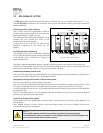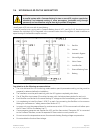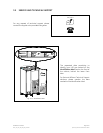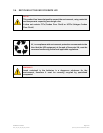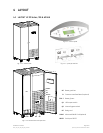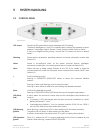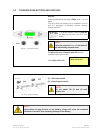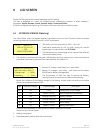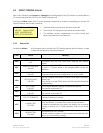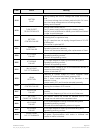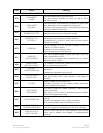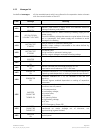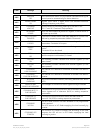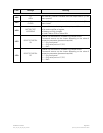
Modifications reserved Page 21/57
OPM_LPS_3UO_30K_40K_0US_V010.doc Operating Manual LP 33 Series 30 & 40 kVA
6 LCD SCREEN
Shows the UPS system data, events messages and UPS setting.
The data is displayed on 4 rows, 20 characters each, allowing the operator to select between 7
languages: English, German, French, Spanish, Italian, Finnish and Polish.
If there is no keypad activity during 1 minute the LCD screen will return to default screen.
6.1 METERING SCREENS (Metering)
This menu allows, when the keypad Metering is pressed, to show on the LCD panel a series of screens
containing metering information about AC and DC parameters.
LP 33 40kVA P1
APPLICATION ON UPS
= 70%
SERVICE REQUIRED
1. UPS family, nominal rating and for RPA: P + No. UPS.
2. Load status: application on UPS, on utility, supply off, manual
bypass (appl. on manual dev.) and ECO Mode.
3. The load amount as a percentage of the nominal load (referred
to the most loaded phase).
4. The signalling, combined with the green LED Operation blinking, is done only in case the respective
parameter (protected by password) has been enabled. See Section 8.4.
Udcp=215V Udcn=215V
Ubp=164V Ubn=164V O
Charge Level = 100%
Autonomy = 15min
1. Booster DC voltage + pole (Udcp) and – pole (Udcn).
2. Battery DC voltage + pole (Ubp), – pole (Ubn) and the status
SBM (Superior Battery Management).
The functionality of SBM can help to reduce the Battery
recharging time, and improve the lifetime of the Battery.
Beside the indication of the Battery voltage on the display, a letter shows, according to the table
below, the operational status of SBM:
Sigle Status of charger Charter voltage Description
O OFF 0 VDC Battery open circuit voltage
T ON Boost (176 VDC) Boost charge with new Battery
F ON Floating (164 VDC) Battery charged
L ON Floating (164 VDC) Normal charge
B ON Boost (176 VDC) Boost charge
E ON Boost (179 VDC) Battery equalization
Access to the Parameters for setting the SBM mode is password protected.
Please call your Service Center.
3. Battery charge level.
4. Estimated battery backup time with actual load.




